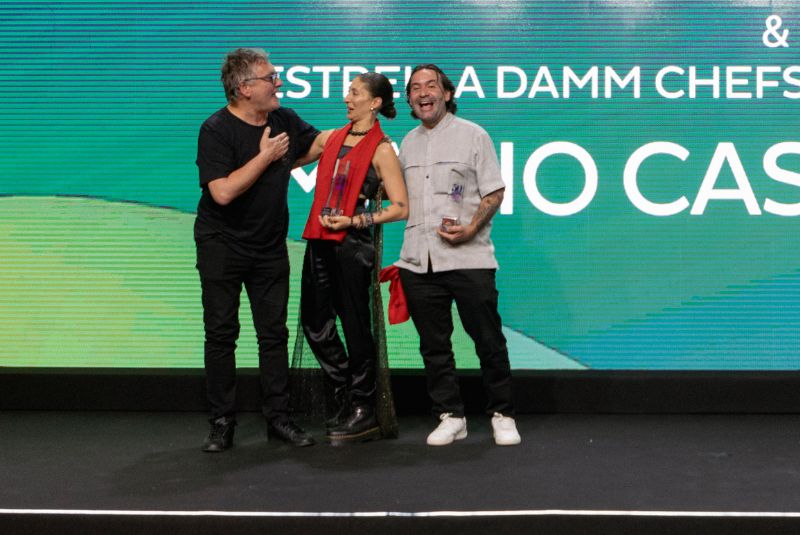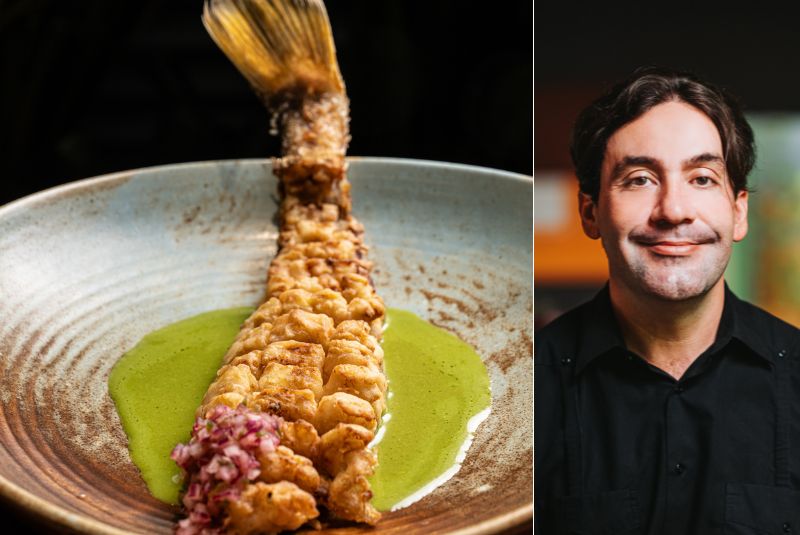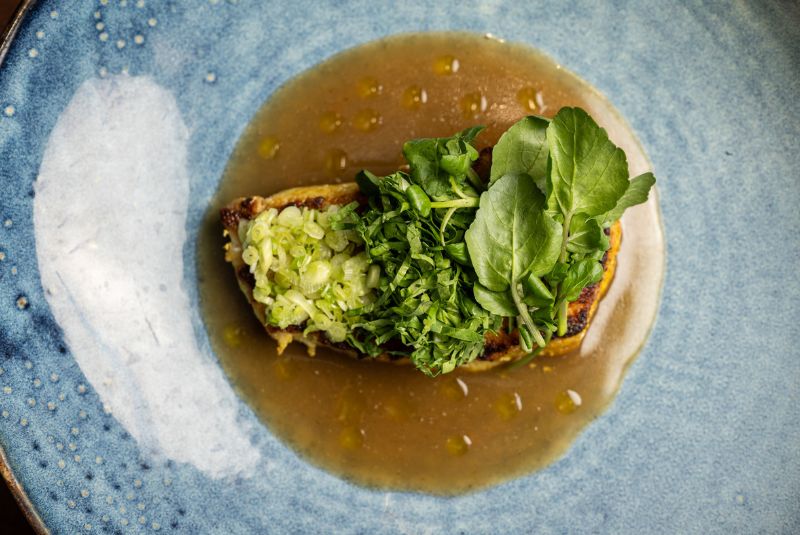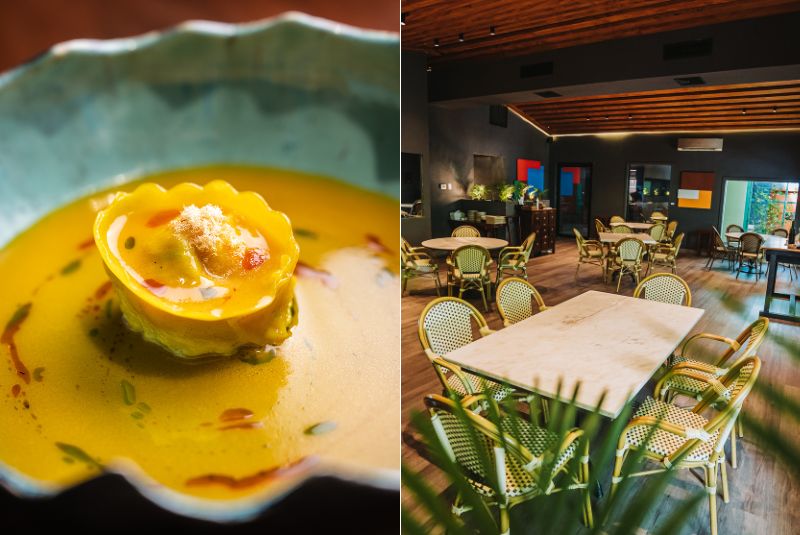With a singular combination of Chinese and Afro-Caribbean influences, Panamanian chef Mario Castrellón has authored a new culinary narrative in Panama. The winner of the Estrella Damm Chefs’ Choice Award, as part of Latin America’s 50 Best Restaurants 2023, explains the spirit of happiness that underpins his work
Imagine turning on the radio and hearing your favourite song – the serotonin starts flowing in your body and you feel immediate pleasure. That’s exactly what Mario Castrellón wants guests to experience when entering his restaurant, Maito. This joyful mood is what Panama’s leading chef-restaurateur calls ‘La Chombasia’.
It was with a similar upbeat energy that Castrellón picked up the Estrella Damm Chefs’ Choice Award at the Latin America’s 50 Best Restaurants awards ceremony in Rio de Janeiro last November. The trophy, voted by his colleagues from across Latin America, reflects the esteem in which the pioneering chef and restaurateur is held; Maito was also named again The Best Restaurant in Panama, occupying the No.6 spot in the ranking.
Castrellón received the trophy from the acclaimed chef Andoni Luis Aduriz
“It was beautiful! And it was really a big surprise,” says Castrellón. “Panama is a country that is only just starting to have more players in the gastronomic world, so you don't expect it. You realise that the country is also growing a little and that we are now under the eye of the gastronomic world. That has been one of the values of Maito: putting Panama in front of the world to generate gastronomic tourism.”
Love (for cooking) always wins
While growing up, the Panamanian was always interested in the kitchen. His parents were not chefs but cooked at home every day and taught young Mario. “It was love at first sight,” he says. As with love, it had some tough moments: “When I was a kid, I burned myself cooking a soup. I was hospitalised with second- and third-degree burns.”
The wounds healed and while Castrellón continued cooking for friends and family, he had other professional plans. “I wanted to be a photographer. I sold photos and worked for a magazine, but when I realised that the life of an artist is not easy, I left it. Then I ended up in the kitchen, which is not any easier either,” he laughs.
Meet Chef Mario Castrellón in our video:
In early 2000, while he was cooking for some friends at the beach and talking of their futures, he decided there and then to study gastronomy instead of photography. A year later he moved to Barcelona for more formal training and has never looked back: “I fell in love and I am still in love with the industry.”
The Chombasia frequency
The term ‘Chombasia’ can’t (yet) be found in the dictionary. It is a phenomenon that Castrellón named to identify the Panamanian flavour profiles and the point of reference for Maito’s cuisine, which was was ideated during the recent pandemic. Searching for a way to highlight the different cultures that coexist in Panama, he unblurred the lines that define the influences that are part of Maito’s menu – and are a fundamental part of the country and its culture.
“I started a line of sandwiches [for delivery when the restaurant was closed]: one more Mediterranean, one with Arab influences, and an Americano-Cantonese blend that emerged with the canal,” he says, stressing that his country’s history is divided in two: before and after the building of the famous Panama Canal.
Once Maito reopened, the team started mixing the Afro-Caribbean influences with the Chinese, and La Chombasia was born. The dish that opened up the route to this new journey in Maito was Pesca Chombasia, a fish cooked with Afro-Caribbean techniques but finished in a Chinese wok. 
The Pesca Chombasia is an unmissable dish when visiting Maito
“La Chombasia has been around for a long time but did not have a name. It is part of the Panamanian flavour profile, this mix between Creole cuisine, Afro curry, Cantonese food and Indian curry,” he says. But La Chombasia goes even further, according to Castrellón: “It is a state of mind. It is a gastronomic frequency of pure happiness and flavour that identifies the Panamanian.”
Giving back to the community
As a young chef, Castrellón had a hunger to travel the world. Then in 2008 he returned to his homeland to work in the restaurant, La Posta; two years later opened his own spot, Maito.
In the early years of the restaurant, while searching for Maito’s culinary identity, he started to work with indigenous communities in a remote area of the country. “'I was researching, looking for the best ingredients of Panama, when I realised that we have one of the most expensive coffees in the world.” Castrellón decided to buy a coffee farm and opened a roastery to honour the ingredient, and discovered that the labour force of the coffee growers was made up of indigenous people.
He worked with three native communities: the Guna, emanating from the Caribbean; the Embera, from the Darién Province which borders Colombia; and the Ngäbe, from the higher-altitude central provinces towards Costa Rica where the most coffee is grown. These communities did not have easy access to basic necessities such as water or electricity.
Castrellón applies what he learned from the indigenous communities in Maito’s menu
“And that's how I met the people of Nutre Hogar, one of the first foundations in the country that is dedicated to fighting child malnutrition,” he explains. The chef worked alongside Nutre Hogar to create a circular economy project with the Ngäbe, where they taught the families of the community to grow organic vegetables. This gave them both food and an income from the surplus, developing a more sustainable future.
Even though the charismatic chef cannot source restaurant ingredients from some of these communities due to their remoteness, he puts into practice what he has learned from them by cooking with native ingredients and sourcing from other indigenous communities closer to Panama City. Endemic produce such as ñampí (a purple root similar to the sweet potato) and dasheen or taro (used in sauces) feature strongly in Maito’s menus.
Never standing still
Castrellón is currently working on a new and ambitious project with the Ngäbe people, this time closer to the Caribbean coast of Panama. The idea is to create a sustainable restaurant that helps the community. "In front of the paradisiac island called the Escudo de Veraguas, where there is a lot of tourism, live these women who cook delicious food. It is where I have eaten some of the best food in my life! We are in the process of fundraising to set up a restaurant and maybe a hotel,” says Castrellón, visibly excited.
Back in the Panaman capital, the Maito group has collaborated with Mitsuharu Tsumura, chef-owner of Maido, named The Best Restaurant in Latin America 2023, sponsored by S.Pellegrino & Acqua Panna. It has resulted in Mai-Mai, a new venture that opened in December, which takes its name from the shared first three letters of each restaurant.
Maito, founded in 2010, is now the flagship for a group of 11 restaurants
Set on a rooftop venue with spectacular views, Mai-Mai is an izakaya-style restaurant combining more casual dishes from the esteemed chefs with cocktails created by former Maybe Sammy bartender Martin Hudák.
Its opening is symptomatic of Castrellón’s restless spirit, never standing still for long but always on the lookout for new adventures. At the same time, Maito has become an established home for national flavours. “It is a restaurant where Panamanians feel identified,” he adds.
What started as a solo project is now the flagship for a group of 11 restaurants, still led by the driving force of Mario Castrellón. At heart, he is motived by the ‘frequency of happiness’ manifested in La Chombasia. It is a spirit that is raising his country’s culinary profile to new heights.
The list of Latin America’s 50 Best Restaurants 2023, sponsored by S.Pellegrino & Acqua Panna, was revealed on 28th November at a live awards ceremony in Rio de Janeiro. Browse the website, join the community on Instagram, follow us on Facebook, visit us on X and subscribe to our YouTube channel and newsletter to stay up to date with the latest news and announcements.

